Enhancing High-Speed Penetration Resistance of Ultra-High-Performance Concrete Through Hybridization of Steel and Glass Fibers
Abstract
1. Introduction
2. Experimental Study
2.1. Materials and Concrete Mixture Proportioning
2.2. Testing Methods
2.2.1. Compressive Testing
2.2.2. Bending Testing
2.2.3. Penetration Testing
2.2.4. Numerical Modeling
3. Result and Discussion
3.1. Compressive Strength
3.2. Modulus of Rupture
3.3. Fracture Toughness
3.4. Depth of Penetration (DOP)
3.5. Crater Area
3.6. Analysis of Numerical Modeling and DOP Prediction by Empirical Models
4. Conclusions
- The mechanical properties of UHPFRCs, particularly compressive strength, had a significant effect on DOP. Thus, using a combination of fibers improved the strength values, which subsequently lowered the DOP values.
- The use of both long and short steel fibers together demonstrated the most effective performance in reducing the damage caused by projectile impacts. The crater area observed in UHPFRC, particularly with steel fibers, was significantly smaller than that of plain concrete. The MSFHSF combination reduced the crater area by up to 88% and proved to be the most effective in minimizing overall damage.
- The ductility of the concretes significantly influenced the crater area, while it had a smaller effect on the DOP values. Concrete targets with higher fracture toughness exhibited lower damage. Visual inspection of the concrete targets after projectile impact showed that using hooked steel fibers substantially reduced the crater area.
- The numerical simulation of the impact process satisfactorily matched the experimental results, with an error range of 2–14%. However, earlier models found in the literature tended to be overly conservative in their predictions of DOP values. Therefore, it is essential to revise these models for high-speed projectile impacts exceeding 1000 m/s, particularly for targets composed of UHPFRCs.
- Fracture toughness can serve as a reliable indicator of ductility in UHPFRC. Using a hybrid combination of fibers significantly increased fracture toughness, leading to enhanced ductility, especially when MSF or glass fibers (GF) were used in conjunction with HSF.
Author Contributions
Funding
Institutional Review Board Statement
Informed Consent Statement
Data Availability Statement
Acknowledgments
Conflicts of Interest
References
- Gesoglu, M.; Guneyisi, E.; Muhyaddin, G.F.; Asaad, D.S. Strain hardening ultra-high performance fiber reinforced cementitious composites: Effect of Fiber Type and Concentration. Compos. Part B 2016, 103, 74–83. [Google Scholar] [CrossRef]
- Rossi, P.; Arca, A.; Parant, E.; Fakhria, P. Bending and compressive behaviours of a new cement composite. Cem. Concr. Res. 2005, 35, 27–33. [Google Scholar] [CrossRef]
- Meng, W.; Khayat, K.H. Effect of hybrid fibers on fresh properties, mechanical properties, and autogenous shrinkage of cost-effective UHPC. J. Mater. Civ. Eng. 2018, 30, 04018030. [Google Scholar] [CrossRef]
- Wu, Z.; Shi, C.; Khayat, K.H. Investigation of mechanical properties and shrinkage of ultra-high performance concrete: Influence of steel fiber content and shape. Compos. Part B 2019, 174, 107021. [Google Scholar] [CrossRef]
- Kwon, S.; Nishiwaki, T.; Kikuta, T.; Mihashi, H. Development of ultra-high-performance hybrid fiber-reinforced cement-based composites. ACI Mater. J. 2014, 111, 309–318. [Google Scholar] [CrossRef]
- Oh, T.; You, I.; Banthia, N.; Yoo, D.Y. Deposition of nanosilica particles on fiber surface for improving interfacial bond and tensile performances of ultra-high-performance fiber-reinforced concrete. Compos. Part B 2021, 221, 109030. [Google Scholar] [CrossRef]
- Yang, J.; Chen, B.; Nuti, C. Influence of steel fiber on compressive properties of ultra-high performance fiber-reinforced concrete. Constr. Build. Mater. 2021, 302, 124104. [Google Scholar] [CrossRef]
- Grünewald, S. Performance-Based Design of Self-Compacting Fibre Reinforced Concrete; TU Delft, Delft University of Technology: Delft, The Netherlands, 2004. [Google Scholar]
- Amanjean, N.E.; Mouret, M.; Vidal, T. Effect of design parameters on the properties of Ultra-High Performance Fibre-Reinforced Concrete in the fresh state. Constr. Build. Mater. 2019, 224, 1007–1017. [Google Scholar] [CrossRef]
- Meng, W.; Valipour, M.; Khayat, K.H. Optimization and performance of Cost-Effective Ultra-High Performance Concrete. Mater. Struct. 2017, 50, 29. [Google Scholar] [CrossRef]
- Kim, D.J.; Naaman, A.E.; El-Tawil, S. Comparative flexural behavior of four fiber reinforced cementitious composites. Cem. Concr. Compos. 2008, 30, 917–928. [Google Scholar] [CrossRef]
- Yoo, D.Y.; Kim, S.W.; Park, J.J. Comparative flexural behavior of ultra-high-performance concrete reinforced with hybrid straight steel fibers. Constr. Build. Mater. 2017, 132, 219–229. [Google Scholar] [CrossRef]
- Niu, Y.; Wei, J.; Jiao, C. Crack propagation behavior of Ultra-High-Performance Concrete (UHPC) reinforced with hybrid steel fibers under flexural loading. Constr. Build. Mater. 2021, 294, 123510. [Google Scholar] [CrossRef]
- Chun, B.; Yoo, D.Y. Hybrid effect of macro and micro steel fibers on the pullout and tensile behaviors of ultra-high-performance concrete. Compos. Part B 2019, 162, 344–360. [Google Scholar] [CrossRef]
- Wu, H.; Fang, Q.; Chen, X.W.; Gong, Z.M.; Liu, J.Z. Projectile penetration of ultra-high performance cement based composites at 510–1320 m/s. Constr. Build. Mater. 2015, 74, 188–200. [Google Scholar] [CrossRef]
- Feng, J.; Gao, X.; Li, J.; Dong, H.; Yao, W.; Wang, X.; Sun, W. Influence of fiber mixture on impact response of ultra-high-performance hybrid fiber reinforced cementitious composite. Compos. Part B 2019, 163, 487–496. [Google Scholar] [CrossRef]
- Das, N.; Nanthagopalan, P. State-of-the-art review on ultra high performance concrete—Ballistic and blast perspective. Cem. Concr. Compos. 2022, 127, 104383. [Google Scholar] [CrossRef]
- Kravanja, S.; Sovjak, R. Ultra high performance concrete fiber-reinforced concrete under high-velocity projectile impact. Part 1. Experiments. Acta Polytech. 2018, 58, 232–239. [Google Scholar] [CrossRef]
- Liu, J.; Wu, C.; Su, Y.; Li, J.; Shao, R.; Chen, G.; Liu, Z. Experimental and numerical studies of ultra-high performance concrete targets against high-velocity projectile impacts. Eng. Struct. 2018, 173, 166–179. [Google Scholar] [CrossRef]
- Liu, J.; Wu, C.; Chen, X. Numerical study of ultra-high performance concrete under non-deformable projectile penetration. Constr. Build. Mater. 2017, 135, 447–458. [Google Scholar] [CrossRef]
- Wu, H.; Fang, Q.; Gong, Z. Experimental and engineering analyses on DOP of HSFRC target under the impact of rigid projectile. J. Ballist. 2012, 24, 19–24. [Google Scholar]
- ASTM C150/C150M-22; Standard Specification for Portland Cement. ASTM International: West Conshohocken, PA, USA, 2022.
- Muhyaddin, G.F. Fiber Reinforced UHPC and its Effects on Load Carrying Capacity of Composite Tube Members According to Current Design Codes. Ph.D. Thesis, Gaziantep University: Gaziantep, Turkey, 2017. [Google Scholar]
- Muhyaddin, G.F. Mechanical and fracture characteristics of ultra-high performance concretes reinforced with hybridization of steel and glass fibers. Heliyon 2023, 9, e17926. [Google Scholar] [CrossRef] [PubMed]
- Hillerborg, A.; Modéer, M.; Petersson, P.E. Determination of the fracture energy of mortar and concrete by means of three-point bend tests on notched beams. Mater. Struct. 1985, 106, 285–290. [Google Scholar] [CrossRef]
- Li, J.; Wu, C.; Hao, H. Investigation of ultra-high performance concrete slab and normal strength concrete slab under contact explosion. Eng. Struct. 2015, 102, 395–408. [Google Scholar] [CrossRef]
- Zhang, F.; Wu, C.; Zhao, X.L.; Heidarpour, A.; Li, Z. Experimental and numerical study of blast resistance of square CFDST columns with steel-fibre reinforced concrete. Eng. Struct. 2017, 149, 50–63. [Google Scholar] [CrossRef]
- Zhang, F.; Wu, C.; Wang, H.; Zhou, Y. Numerical simulation of concrete filled steel tube columns against BLAST loads. Thin-Walled Struct. 2015, 92, 82–92. [Google Scholar] [CrossRef]
- Wu, Y.; Crawford, J.; Lan, S.; Magallanes, J. Validation studies for concrete constitutive models with blast test data. In Proceedings of the 13th International LS-DYNA Users Conference, Dearborn, MI, USA, 8–10 June 2014; LSTC: Livermore, CA, USA, 2014. [Google Scholar]
- Luccionia, B.; Aráozb, G. Erosion criteria for frictional materials under blast load. Mecánica Comput. 2011, 30, 1809–1831. [Google Scholar]
- Liu, J.; Wu, C.; Li, J.; Su, Y.; Shao, R.; Liu, Z.; Chen, G. Experimental and numerical study of reactive powder concrete reinforced with steel wire mesh against projectile penetration. Int. J. Impact Eng. 2017, 109, 131–149. [Google Scholar] [CrossRef]
- Livermore Software Technology Corporation (LSTC). LS-DYNA Keyword User’s Manual, Volume II: Material Models; LSTC: Livermore, CA, USA, 2002. [Google Scholar]
- Iqbal, S.H.; Ali, A.; Holschemacher, K.; Thomas, A. Mechanical properties of steel fiber reinforced high strength lightweight self-compacting concrete (SHLSCC). Constr. Build. Mater. 2015, 98, 325–333. [Google Scholar] [CrossRef]
- Yu, R.; Spiesz, P.; Brouwers, H.J. Static Properties and impact resistance of a green ultra-high performance hybrid fibre reinforced concrete (UHPHFRC): Experiments and Modeling. Constr. Build. Mater. 2014, 68, 158–171. [Google Scholar] [CrossRef]
- Hassan Pour, M.; Shafigh, P.; Mahmud, H.B. Lightweight aggregate concrete fiber reinforcement: A review. Constr. Build. Mater. 2012, 37, 452–461. [Google Scholar] [CrossRef]
- Kennedy, R. A review of procedures for the analysis and design of concrete structures to resist missile impact effects. Nucl. Eng. Des. 1976, 37, 183–203. [Google Scholar] [CrossRef]
- Siddique, R.; Mehta, P.K. Hybrid fiber-reinforced ultra-high-performance concrete: Mechanical and impact resistance properties. Constr. Build. Mat. 2014, 54, 248–256. [Google Scholar] [CrossRef]
- Kou, S.C.; Poon, C.S.; Chan, D. Impact resistance and energy absorption of ultra-high-performance fiber-reinforced concrete under projectile impact. Mater. Des. 2017, 119, 154–163. [Google Scholar] [CrossRef]
- Forrestal, M.J.; Tzou, D.Y. A spherical cavity-expansion penetration model for concrete targets. Int. J. Solids Struct. 1997, 34, 4127–4146. [Google Scholar] [CrossRef]
- Zang, M.H.; Shim, V.P.W.; Lu, G.; Chew, C.W. Resistance of high-strength concrete to projectile impact. Int. J. Impact Eng. 2005, 31, 825–841. [Google Scholar] [CrossRef]

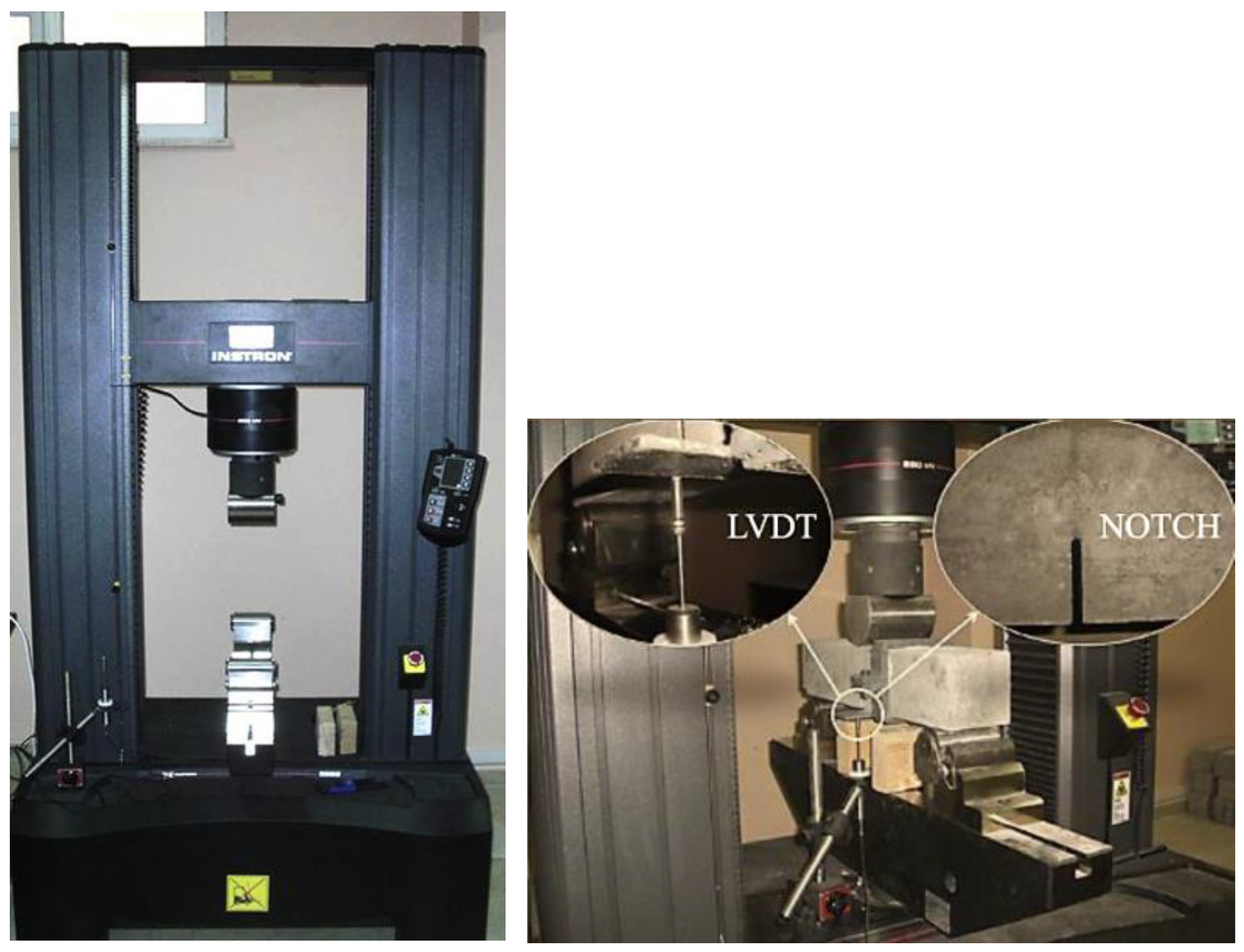
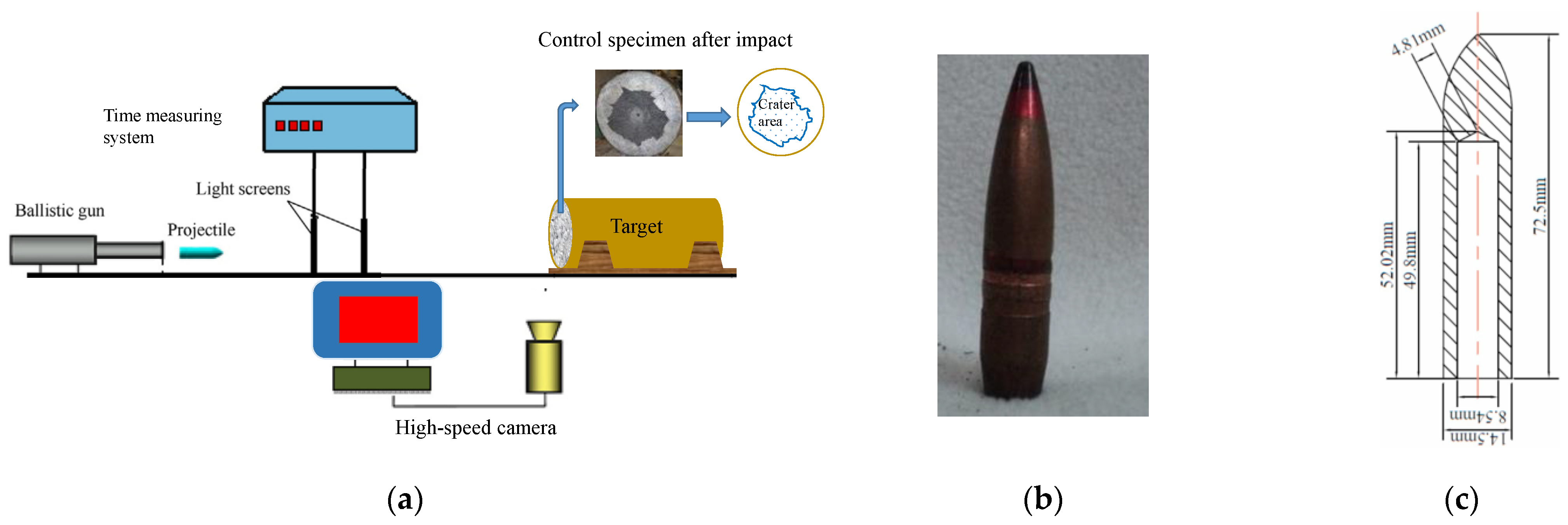
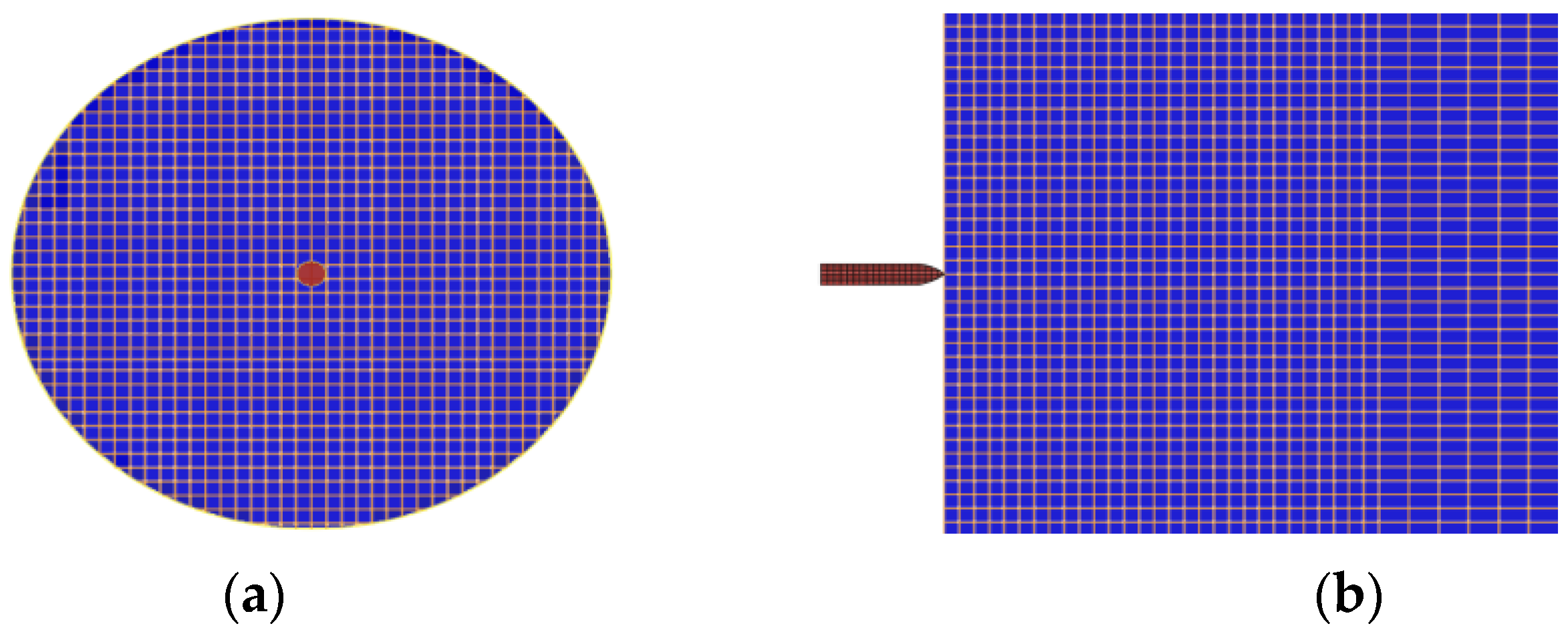
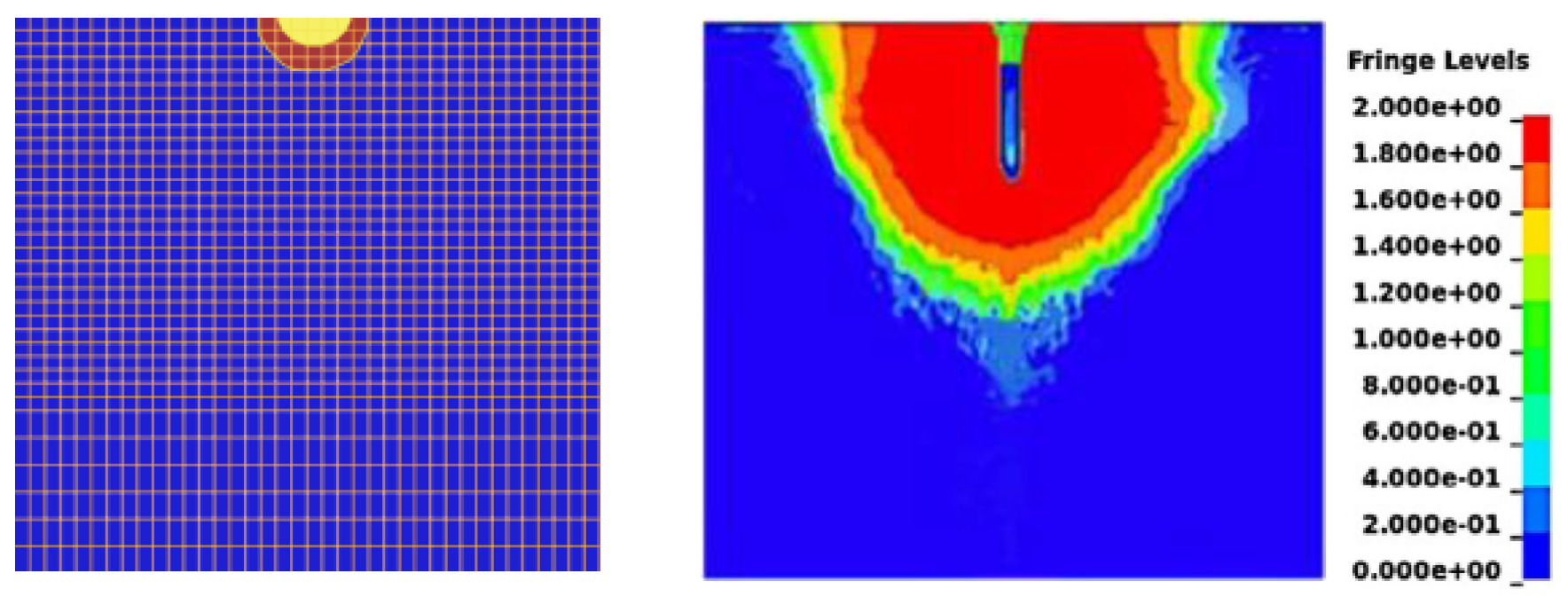
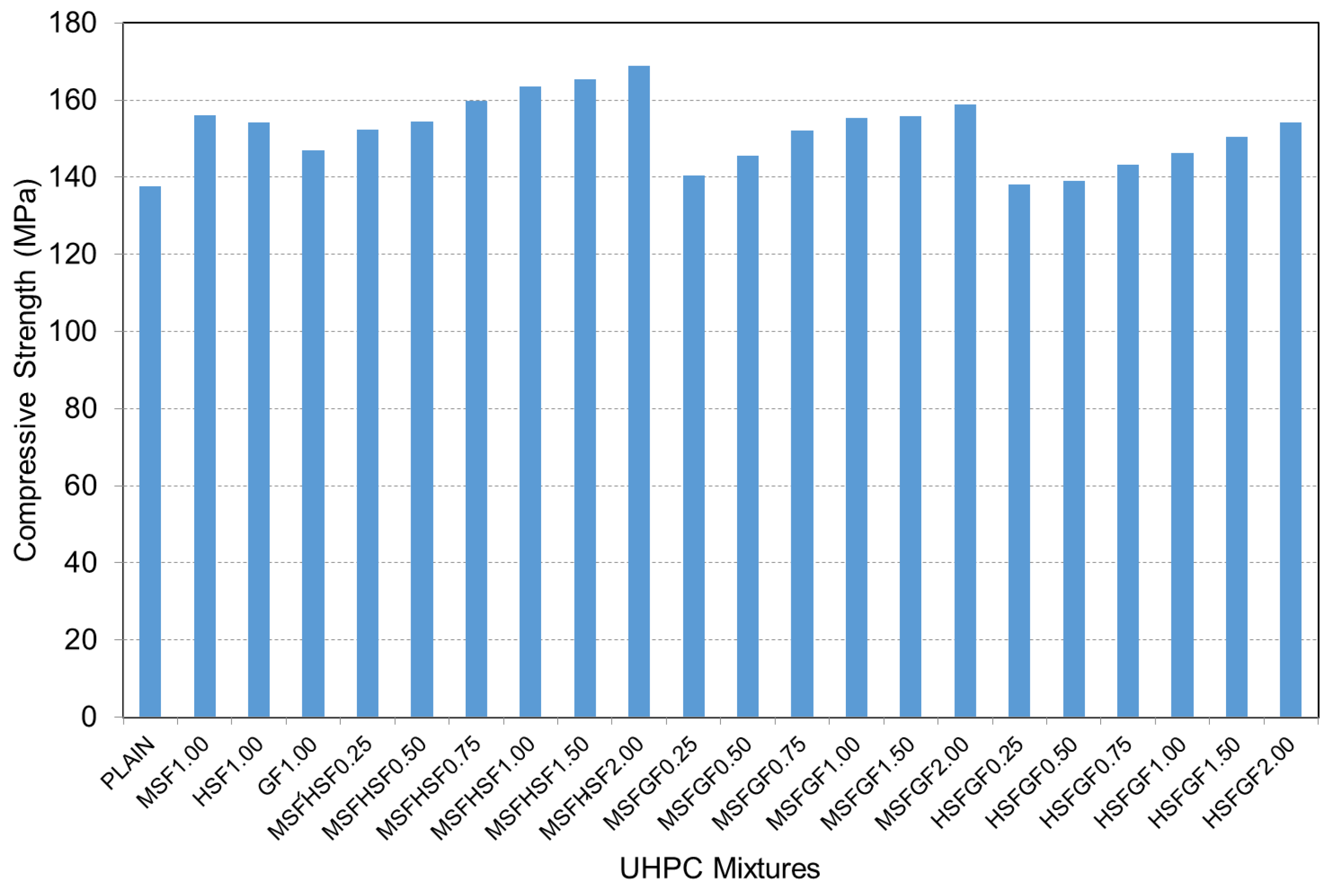

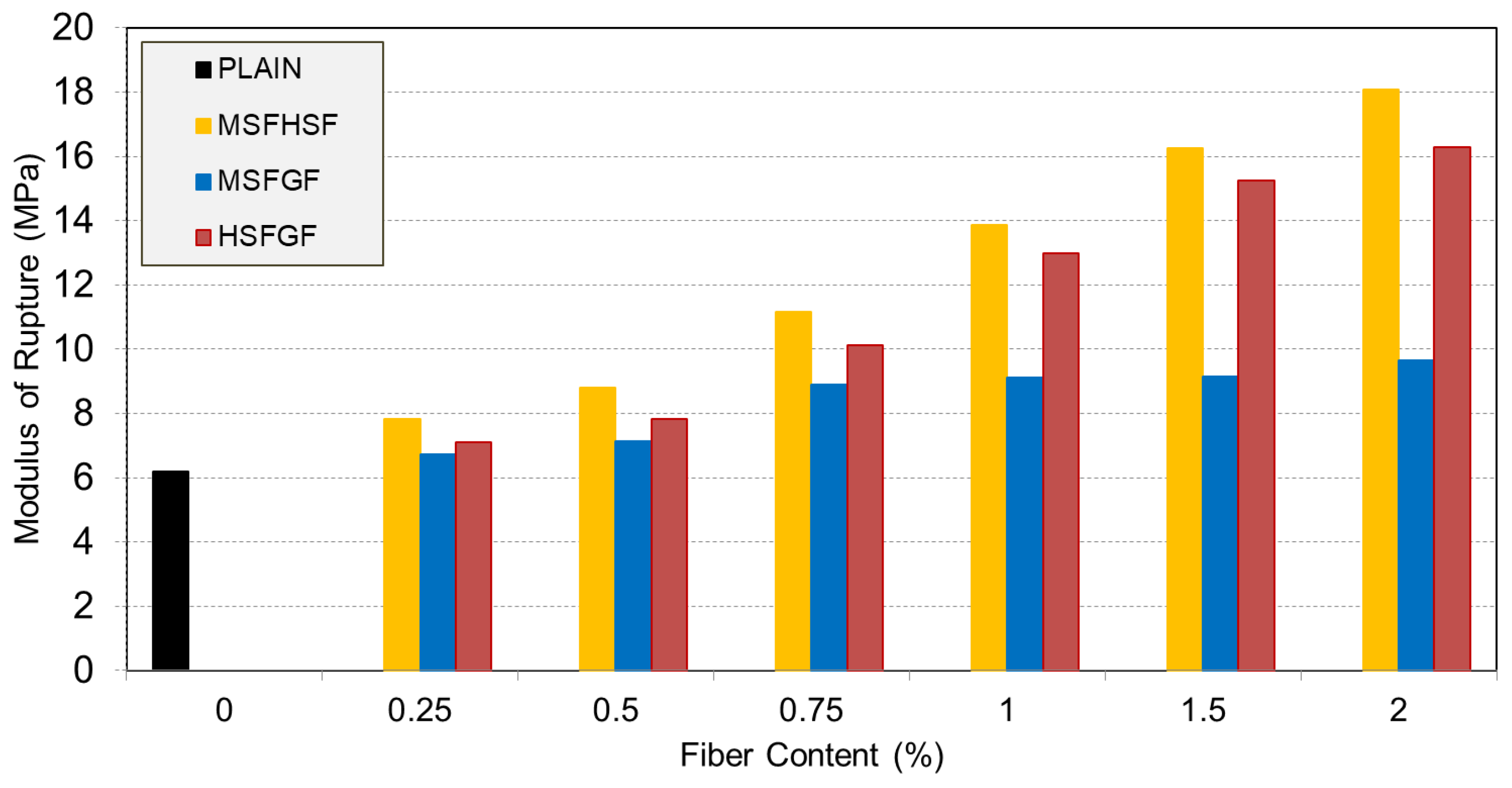
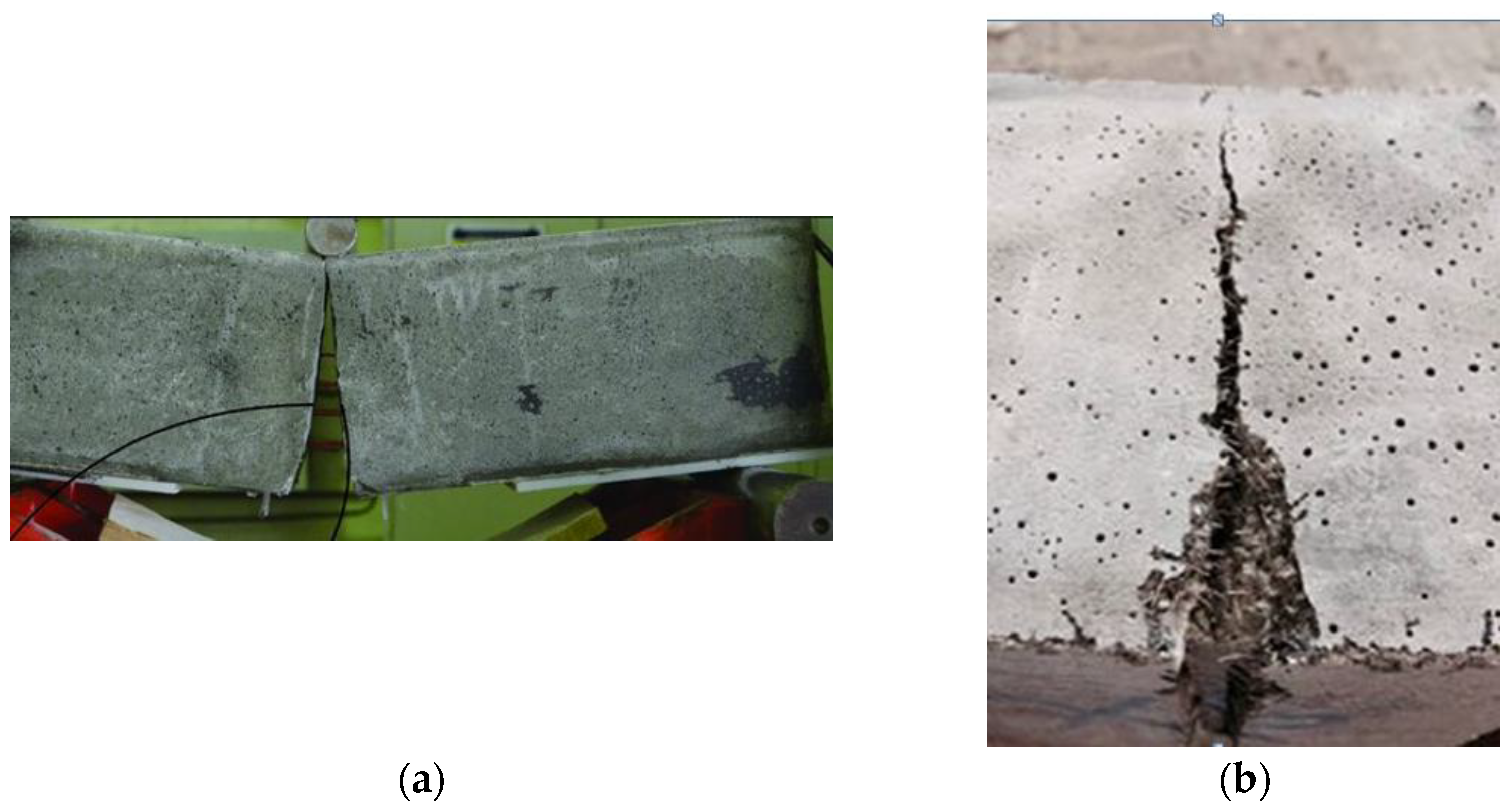
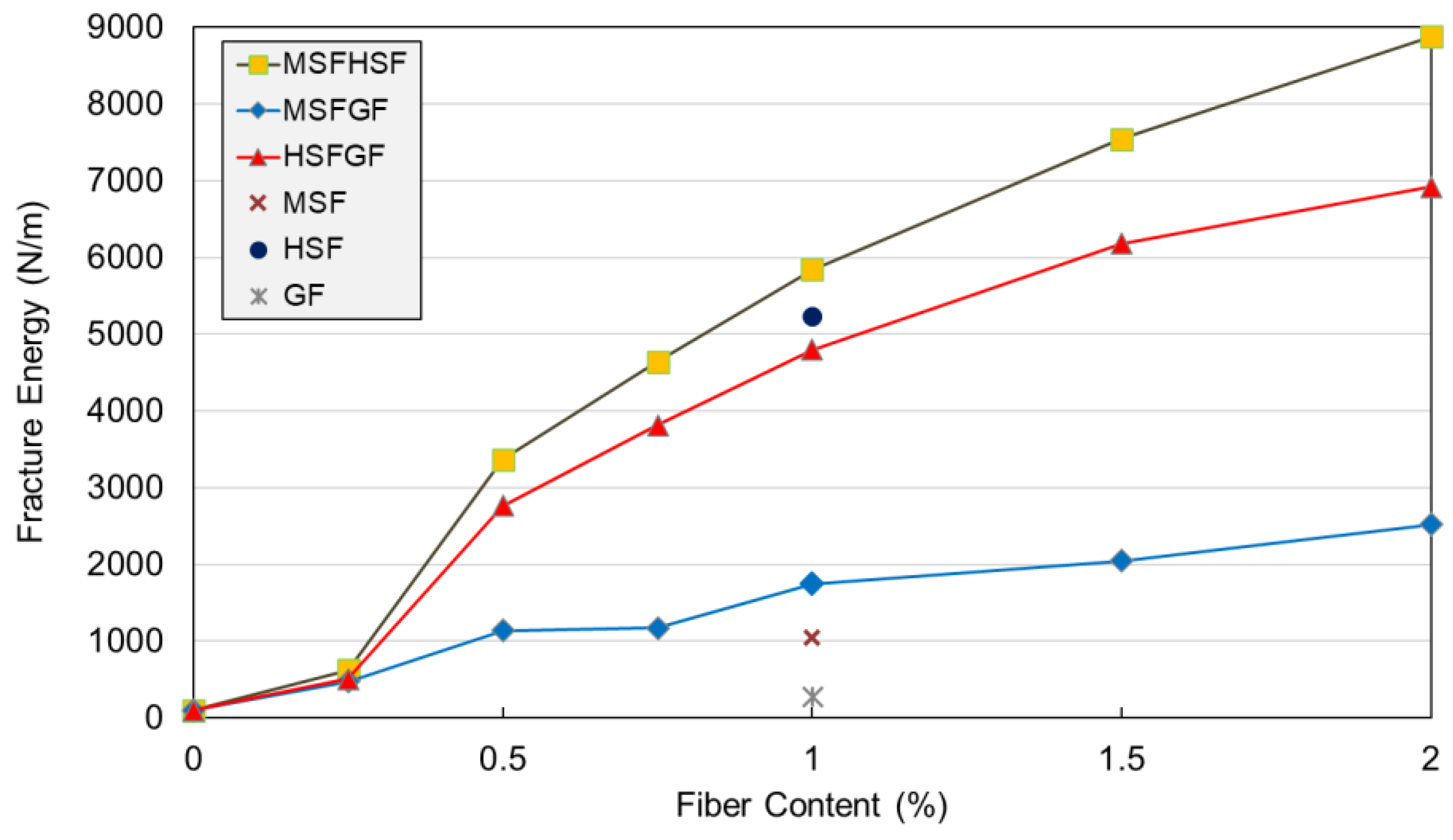
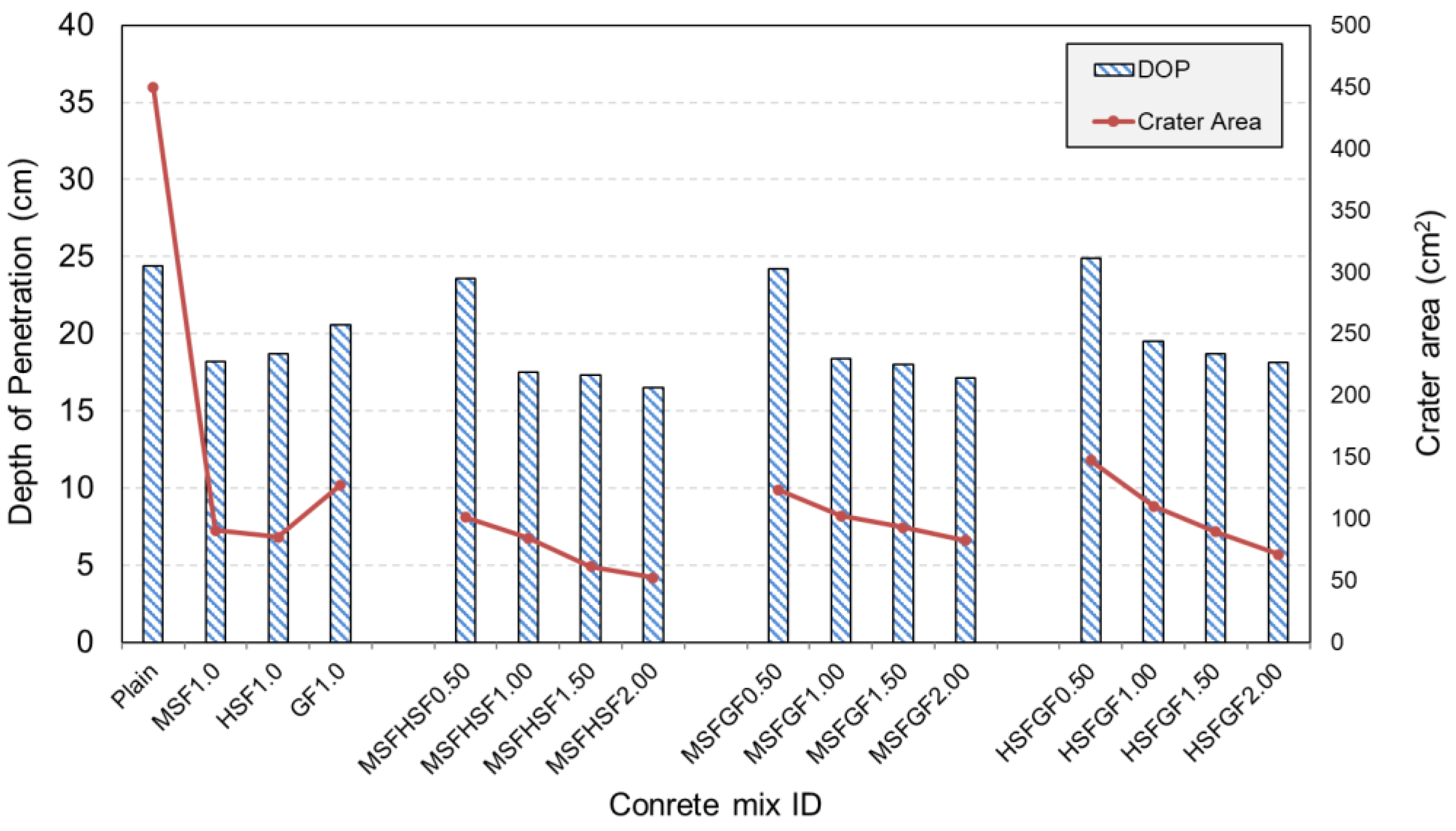


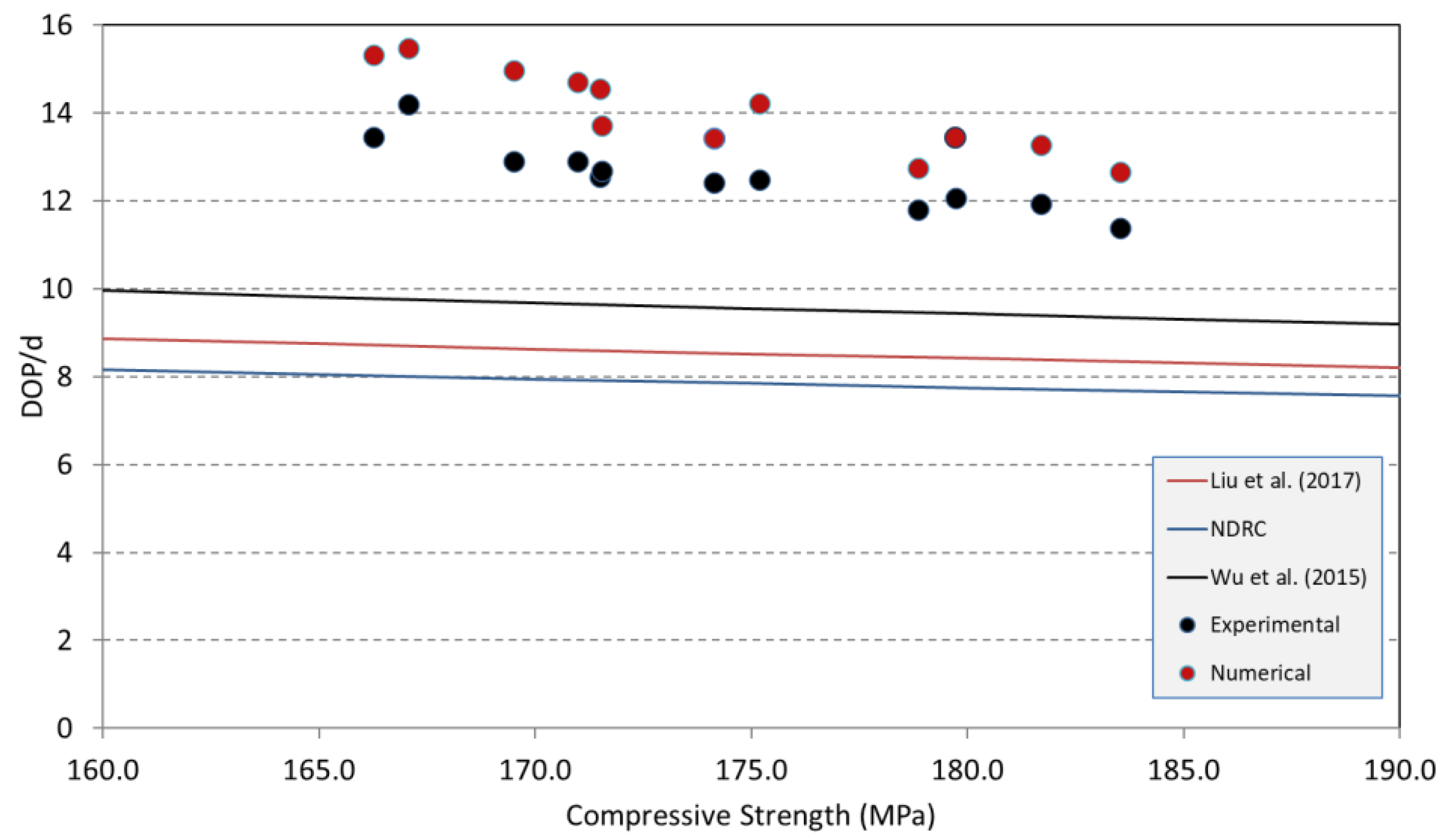
| Types of Fiber | Diameter (D) (mm) | Length (L) (mm) | Aspect Ratio (L/D) | Tensile Strength (MPa) | Density (g/cm3) |
|---|---|---|---|---|---|
| Steel | 0.16 | 6 | 37.5 | 2250 | 7.17 |
| Hooked steel | 0.55 | 30 | 55 | 1345 | 7.85 |
| Glass | 0.018 | 13 | 722 | 2000 | 2.6 |
| Mixture ID | Cement (kg/m3) | SF (kg/m3) | Water (kg/m3) | SP (kg/m3) | MSF (kg/m3) (%) | HSF (kg/m3) (%) | GF (kg/m3) (%) | Aggregates (kg/m3) |
|---|---|---|---|---|---|---|---|---|
| Plain | 0 (0) | 0 (0) | 0 (0) | 793.7 | ||||
| MSF1.0 | 960 | 240 | 234 | 45 | 71.70 (1) | 0 (0) | 0 (0) | 767.2 |
| HSF1.0 | 0 (0) | 78.5 (1) | 0 (0) | 764.7 | ||||
| GF1.0 | 0 (0) | 0 (0) | 26.0 (1) | 798.8 | ||||
| MSFHSF0.25 | 8.96 (0.125) | 9.81 (0.125) | 757.6 | |||||
| MSFHSF0.50 | 17.93 (0.25) | 19.63 (0.25) | 780.5 | |||||
| MSFHSF0.75 | 960 | 240 | 234 | 51 | 26.89 (0.375) | 29.44 (0.375) | 0 (0) | 773.8 |
| MSFHSF1.00 | 35.85 (0.5) | 39.25 (0.5) | 767.2 | |||||
| MSFHSF1.50 | 53.78 (0.75) | 58.88 (0.75) | 754.0 | |||||
| MSFHSF2.00 | 71.70 (1) | 78.50 (1) | 726,0 | |||||
| MSFGF0.25 | 8.96 (0.125) | 3.25 (0.125) | 809,2 | |||||
| MSFGF0.50 | 17.93 (0.25) | 6.50 (0.25) | 802.5 | |||||
| MSFGF0.75 | 960 | 240 | 234 | 60 | 26.89 (0.375) | 0 (0) | 9.75 (0.375) | 795.9 |
| MSFGF1.00 | 35.85 (0.5) | 13.00 (0.5) | 789.3 | |||||
| MSFGF1.50 | 53.78 (0.75) | 19.50 (0.75) | 717.2 | |||||
| MSFGF2.00 | 71.70 (1) | 26.00 (1) | 696.5 | |||||
| HSFGF0.25 | 9.81 (0.125) | 3.25 (0.125) | 794.4 | |||||
| HSFGF0.50 | 19.63 (0.25) | 6.50 (0.25) | 787.8 | |||||
| HSFGF0.75 | 960 | 240 | 234 | 51 | 0 | 29.44 (0.375) | 9.75 (0.375) | 773.8 |
| HSFGF1.00 | 39.25 (0.5) | 13.00 (0.5) | 767.2 | |||||
| HSFGF1.50 | 58.88 (0.75) | 19.50 (0.75) | 739.2 | |||||
| HSFGF2.00 | 78.50 (1) | 26.00 (1) | 711.3 |
| Mixture ID | Compressive Strength (MPa) | Modulus of Rupture (MPa) | Fracture Energy (N/mm) |
|---|---|---|---|
| Plain | 137.6 | 6.18 | 103.7 |
| MSF1.00 | 156.1 | 7.01 | 1046.9 |
| HSF1.00 | 154.2 | 12.19 | 5239.7 |
| GF1.00 | 147.0 | 8.27 | 276.0 |
| MSFHSF0.25 | 152.3 | 7.81 | 621.8 |
| MSFHSF0.50 | 154.5 | 8.81 | 3370.6 |
| MSFHSF0.75 | 159.9 | 11.15 | 4642.0 |
| MSFHSF1.00 | 163.5 | 13.86 | 5841.6 |
| MSFHSF1.50 | 165.3 | 16.25 | 7540.4 |
| MSFHSF2.00 | 168.8 | 18.08 | 8879.9 |
| MSFGF0.25 | 140.4 | 6.74 | 471.5 |
| MSFGF0.50 | 145.5 | 7.14 | 1136.6 |
| MSFGF0.75 | 152.0 | 8.90 | 1172.6 |
| MSFGF1.00 | 155.3 | 9.12 | 1739.4 |
| MSFGF1.50 | 155.9 | 9.15 | 2044.8 |
| MSFGF2.00 | 158.8 | 9.64 | 2520.8 |
| HSFGF0.25 | 138.1 | 7.10 | 506.7 |
| HSFGF0.50 | 139.1 | 7.84 | 2765.4 |
| HSFGF0.75 | 143.2 | 10.12 | 3813.7 |
| HSFGF1.00 | 146.3 | 12.98 | 4797.0 |
| HSFGF1.50 | 150.5 | 15.24 | 6183.3 |
| HSFGF2.00 | 154.2 | 16.27 | 6917.0 |
Disclaimer/Publisher’s Note: The statements, opinions and data contained in all publications are solely those of the individual author(s) and contributor(s) and not of MDPI and/or the editor(s). MDPI and/or the editor(s) disclaim responsibility for any injury to people or property resulting from any ideas, methods, instructions or products referred to in the content. |
© 2025 by the authors. Licensee MDPI, Basel, Switzerland. This article is an open access article distributed under the terms and conditions of the Creative Commons Attribution (CC BY) license (https://creativecommons.org/licenses/by/4.0/).
Share and Cite
Gesoglu, M.; Muhyaddin, G.F.; Yardim, Y.; Corradi, M. Enhancing High-Speed Penetration Resistance of Ultra-High-Performance Concrete Through Hybridization of Steel and Glass Fibers. Materials 2025, 18, 2715. https://doi.org/10.3390/ma18122715
Gesoglu M, Muhyaddin GF, Yardim Y, Corradi M. Enhancing High-Speed Penetration Resistance of Ultra-High-Performance Concrete Through Hybridization of Steel and Glass Fibers. Materials. 2025; 18(12):2715. https://doi.org/10.3390/ma18122715
Chicago/Turabian StyleGesoglu, Mehmet, Guler Fakhraddin Muhyaddin, Yavuz Yardim, and Marco Corradi. 2025. "Enhancing High-Speed Penetration Resistance of Ultra-High-Performance Concrete Through Hybridization of Steel and Glass Fibers" Materials 18, no. 12: 2715. https://doi.org/10.3390/ma18122715
APA StyleGesoglu, M., Muhyaddin, G. F., Yardim, Y., & Corradi, M. (2025). Enhancing High-Speed Penetration Resistance of Ultra-High-Performance Concrete Through Hybridization of Steel and Glass Fibers. Materials, 18(12), 2715. https://doi.org/10.3390/ma18122715








